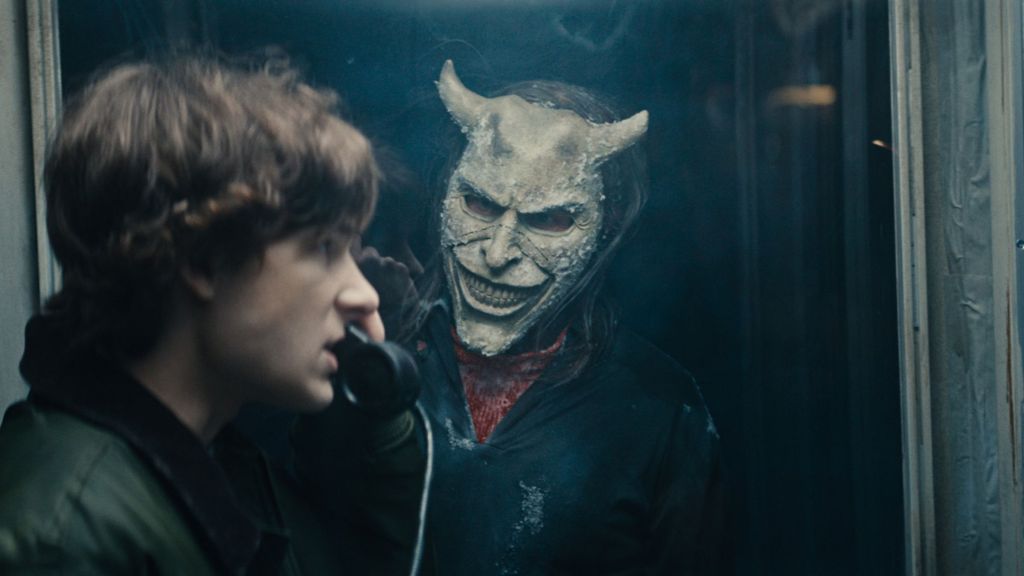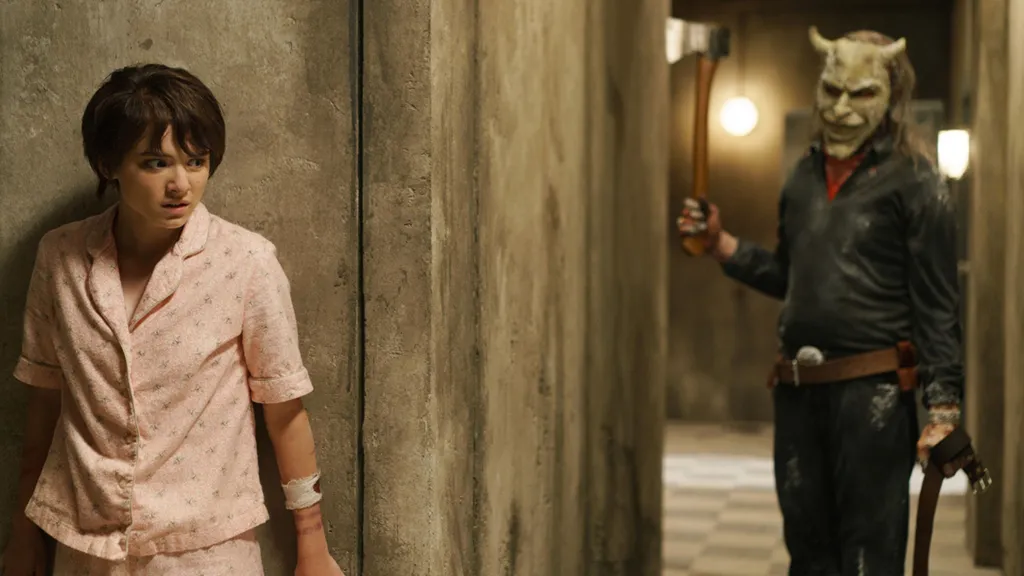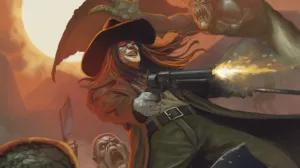The Black Phone became a surprising hit for Blumhouse back in 2022. Produced on a budget ranging from $16 to $18 million, the movie went on to grab $161 million at the box office, becoming one of the company’s most profitable ventures. Yet, the idea of a sequel seemed strange, as the first movie has a very definitive ending, with the Grabber (Ethan Hawke) dead and the siblings Finney (Mason Thames) and Gwen (Madeleine McGraw) reunited. Of course, a sequel was inevitable, as the potential profit was too tempting to ignore. Luckily, Black Phone 2 manages to justify its existence with a fresh hook that expands its predecessor’s mythology while delving even deeper into its audacious genre mashup.
Videos by ComicBook.com
Set four years after the events of The Black Phone, the sequel finds Finney and Gwen completely changed by their previous ordeal. Unable to cope with the trauma of being kidnapped and forced to kill his abductor, Finney grew up to be an angry teenager, pushing everyone away except his family. As for Gwen, she’s ostracized by the persistent whispers about her paranormal abilities, turning her into a pariah at school. The siblings’ bond is put to the test yet again when their connection with the afterlife draws them to Alpine Lake, a Christian youth camp with connections to their mother, Hope Adler (Anna Lore), and the Grabber himself.
While the truth of these connections is best discovered in the movie theater, Black Phone 2 never feels cheap, delivering a story that rewrites the canon without contradicting the rules set by the first movie. Instead, director and co-writer Scott Derickson is interested in exploring the logical limits of the world he helped create for the screens. That results in an unexpectedly wild cinematic experience that is mesmerizing, at least for its first hour. Sadly, Black Phone 2 is also pulled back by some glaring pacing issues and Derickson’s struggle to deal with abrupt tone shifts. That’s not enough to derail the sequel, but it still robs some of its charm.
Rating: 3.5 out of 5
| PROS | CONS |
| Stylish and atmospheric direction from Scott Derrickson | Overly sentimental emotional scenes that feel out of place |
| Visually stunning dream sequences with analog-horror flair | Heavy-handed exposition that slows the story |
| Moody, well-lit cinematography that enhances tension | Underused Christian camp setting with shallow thematic payoff |
| Expands the original’s mythology without breaking continuity | Pacing issues in the second half |
| Strong first half with gripping horror and mystery elements | |
| High production quality that feels cinematic and polished |
At Its Best, Black Phone 2 Is Enthralling

The first thing you notice in Black Phone 2 is how good it looks. The first movie is far from being an eyesore, perfectly capturing the feel of the 1970s. Still, for the sequel, Derickson used every penny of the sequel’s $30 million budget to make Black Phone 2 as stylish as it could be. Digging deeper into Gwen’s psychic powers, the movie alternates between reality and grainy dreamscapes. Each sequence set within the girl’s visions adds a grainy texture inspired by the best of analog horror. The dream sequences also have their own editing and framing, sometimes echoing elements of found footage.
These sequences, often without dialogue, are exercises in despair, with newcomer composer Atticus Derickson using synthesizers to craft a spine-chilling soundtrack that gets your heart racing every time Gwen dares to close her eyes. The result is a distinctive language that sets the tone for Black Phone 2‘s exploration of the past through Gwen’s dreams, a dangerous endeavor underlined by a perfect marriage of sound, image, and fear.
Cinematographer Pär M. Ekberg also knocks it out of the park outside the dream sequences. Almost the entirety of Black Phone 2‘s story unfolds in the dead of the night, and a significant chunk of the movie happens in white snowfields. Given Hollywood’s recent trend of ignoring proper lighting and mistaking darkness for atmosphere, Black Phone 2 could have fallen into the trap of hiding too much in the shadows. On the contrary, the sequel manages to make every night scene easy to follow, with the welcome addition of a blue hue to some nocturnal shots that only contributes to the movie’s slickness.

The technical excellence of Black Phone 2 helps to put you immediately in the mood for the movie’s mix of serial killer investigation and supernatural puzzle box. For its first hour, we are taken on a slow descent into madness as Gwen and Finney learn more about their mother, the Grabber, and their own connection to spirits. There’s also a new murder mystery to be solved, revolving around three children who vanished at Alpine Lake over two decades before the events of the film.
In the middle of its runtime, though, Black Phone 2 has a major narrative shift that reframes the movie’s goals. While the transition is somewhat shaky, it also allows Derickson to unleash his twisted creativity into breathtaking set pieces that play with the boundaries of dreams and reality. It’s obvious by then that Black Phone 2 is a love letter to A Nightmare on Elm Street, and the sequel is better for it.
Black Phone 2 Struggles With Pacing and Tone

Even though there’s a lot to love in Black Phone 2, the sequel is far from perfect. For starters, the script by Derickson and C. Robert Cargill struggles to find the right balance between letting the dread build up organically and ensuring the audience understands the movie’s supernatural rules. That leads to some unfortunate exposition scenes that break the rhythm by having characters explain to each other exactly what’s happening and what’s at stake. The pacing of Black Phone 2 takes another hit due to its bulky runtime of almost two hours. Once Derickson shows all his cards, and it’s obvious where things are going, the last stretch of the story becomes a waiting game, which harms the movie’s momentum.
Black Phone 2 also struggles with its young adult drama. Derickson is a marvelous horror director, one of the best in Hollywood, and he knows how to direct the heck out of a scene meant to make you shiver. The same can’t be said for overly emotional scenes. Black Phone 2 has some moments that take a step away from horror to let its teenage cast reflect on their feelings. These scenes are often too saccharine for the movie’s tone, feeling extremely out of place and bland, despite the quality of the sequel’s cast. While the goal is for Black Phone 2 to be uplifting, the unintentional cringe of these scenes is arguably the worst aspect of the movie.

Finally, Black Phone 2‘s setting is not used to its full potential. By setting the story in a Christian youth camp, the sequel alludes to bigger philosophical discussions about faith and the existence of a higher power. Unfortunately, the script gets stuck in the middle of the road, without knowing what it wants to say about Christianity. The result is shallow dialogue that adds little to the plot or the characters, and whose uselessness only becomes more apparent due to the sequel’s bloated runtime.
Black Phone 2 is still a fun ride, filled with thrills and genuine scares. As such, it’s an easy recommendation for any horror fiend, especially during Spooky Season. Some of its flaws prevent it from being the instant classic that it had the potential to be. Nevertheless, the sequel is as good as the original, bringing the right amount of novelty to keep fans engaged. If a third movie ever comes to fruition, we’re still excited to see where Derickson will take us next.
Black Phone 2 hits theaters on October 16th.









